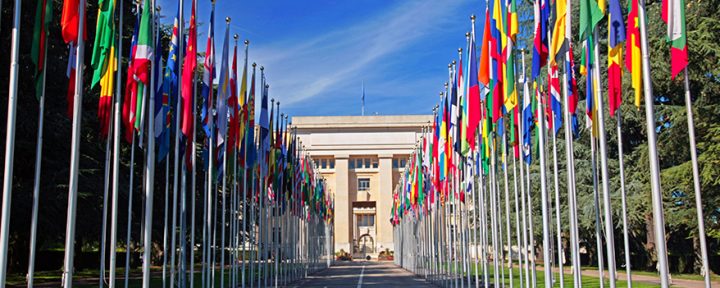Another round of preparatory meetings ahead of the 2020 NPT Review Conference kicks off in Geneva tomorrow, Monday 23rd April. The people at Reaching Critical Will are, as always, providing excellent coverage throughout. We republish their first editorial here for the benefit of Pressenza readers.
Since states parties to the nuclear Non-Proliferation Treaty (NPT) last met in 2017, there have been changes on the nuclear disarmament landscape.
Most notable is the adoption in July 2017 of the Treaty on the Prohibition of Nuclear Weapons (TPNW), which outlaws the development, possession, use, and threat of use of nuclear weapons. This Treaty is the outcome of years of discussion on the humanitarian impact of nuclear weapons and the recognition that the only way to prevent these weapons from being used is to prohibit and eliminate them. Two-thirds of UN member states adopted the Treaty and momentum continues to build as more states sign and ratify it—more are expected to do so imminently.
Nuclear-armed states or those that include nuclear weapons in their security doctrines continue to view the TPNW as distracting or even damaging to the disarmament community and international security. In their strange calculus, more nuclear weapons make our world safer. They have argued that the Treaty and its proponents have created divisions in the international community and that the TPNW challenges the NPT.
This is inaccurate. Divided and differing views about nuclear weapons have always existed. What has changed in the last year is that states and other actors have at last given voice to their collective dissatisfaction by developing a new legal instrument that delegitimises nuclear weapons and makes them illegal, in order to fill a gap in international law and complement the NPT.[1] Let’s not forget that the NPT itself sets out both the rationale and obligation to ban nuclear weapons and highlights the catastrophic consequences of the use of nuclear weapons as motivation for preventing proliferation and achieving disarmament. This is also a primary motivation of the TPNW. As stipulated in article VI of the NPT, it is the responsibility of all states to make progress towards negotiations on nuclear disarmament. Any step towards the categorical prohibition of nuclear weapons is consistent with the NPT and constitutes an “effective measure” such as referred to in article VI. Several states and civil society look forward to seeing the positive interplay between the NPT and TPNW unfold, such as with other agreements that reinforce NPT provisions.
It’s really the areas where there has been no change that states parties should focus on most. Many of the challenges and priorities facing this review cycle are found in unfulfilled commitments, actions not taken, and political deadlock.[2] The action plan from the 2010 NPT Review Conference remains only partially implemented. Only five of 22 action points on disarmament actions saw substantial forward movement. The non-nuclear-armed states parties who maintain a doctrine of “extended nuclear deterrence” have shown no signs of movement towards diminishing the role of nuclear weapons in their military concepts. Many, in fact, have become even more resolute in their defence of nuclear weapons as legitimate and necessary. All nuclear-armed states parties are “modernising”’ and in some cases expanding their arsenals of warheads and delivery systems.
The longstanding, unresolved issue of a nuclear weapon free zone in the Middle East is a priority for states parties. Progress has been stilted yet it will be challenging to progress that issue at this conference, given the uncertain future of the Joint Comprehensive Plan of Action (JCPOA). The next deadline for the United States to recertify the deal and waive its sanctions on Iran is just a week after the end of the PrepCom. It’s no secret that the current US administration does not see value in the JCPOA, despite the efforts of other partners to ensure it continues to hold. The collapse of the JCPOA would, in the immediate term, put an end to the controls it established on Iran’s nuclear programme but more broadly, impact regional stability, complicating the potential for progress on relevant NPT commitments.[3] There are warnings of a nuclear crisis.
This may also, in turn, influence upcoming talks between the leaders of the US and the Democratic People’s Republic of Korea (DPRK), in the sense that the DPRK may re-consider its newfound support for denuclearisation and trust in the international community.[4] The still tenuous yet improving relationships between DPRK and South Korea, and DPRK and the US, as well steps toward ending testing and development are extremely welcome and to be encouraged. Yet they are also very fragile. It is anticipated that there could be a ripple effect into the conference room from the inter-Korean summit on 27 April.
Between what has changed and what remains the same, what is constant is achieving nuclear disarmament now, amidst rising tensions and increasingly aggressive use of force around the world, is more important than ever.
[1] See, Preventing Collapse: the NPT and a ban on nuclear weapons, Reaching Critical Will, April 2013.
[2] For further information, see 2018 NPT Briefing Book, Reaching Critical Will of the Women’s International League for Peace and Freedom, March 2018.
[3] “‘It will not be very pleasant,’ Iran warns, if Trump sabotages nuclear deal”, The Guardian, 22 April 2018.
[4] David E. Sanger, “How Trump’s Disdain for the Iran Deal Makes a North Korea Pact Even Harder”, New York Times, 22 March 2018.










